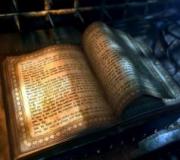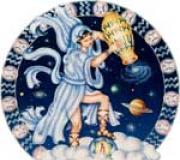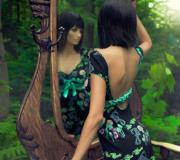In one happy childhood read online. Literary reading tests "in one happy childhood"
3rd ed., revised. - M.: 2008; Part 1 - 208 p.
Tutorial on literary reading is designed to work with 3rd grade students in a four-year primary school and is a continuation of the course "Reading and Primary literary education". Corresponds to the "Mandatory Minimum..." (1998) and the Federal Component of the State Standard general education(2004), is integral part set of textbooks of the Educational system "School 2100". The purpose of the textbook is further development reading skills, interest in the reading process itself; intellectual, speech and aesthetic development children.
Part 1.
Format: pdf
Size: 46.3 MB
Watch, download: docs.google.com ; rusfolder.com
Part 1.
Third grader who will read this book 3
G. Sapgir. PAINTED SUN 4
Y. Kim. BRIGHT DAY 5
Section 1. FAREWELL TO SUMMER
B. Dragunsky. ENGLISH PAUL 8
E. Uspensky. UNCLE FEDOR, THE DOG AND THE CAT (chapters) 12
K. Balmont. DROP 19
B. Zakhoder. WHAT IS THE MOST BEAUTIFUL OF ALL? 20
Section 2. SUMMER TRAVEL AND ADVENTURE
Y. Kim. BRAVE HUNTER 24
S. Golitsyn. FORTY PROSPECTERS (chapters) 25
Go to. IN THE DEBERS OF KARA-BUMBA (chapters) 44
M. Twain. THE ADVENTURES OF TOM SAWYER (Chapters) 55
B. Emelyanov. GAME (from the book “Stories about Gaidar”) 69
K. Paustovsky. CAT THIEF 74
K. Paustovsky. RESIDENTS OF THE OLD HOUSE 78
Section 3. NATURE IN SUMMER
S. Yesenin. GOOD MORNING! 88
A. Chekhov. STEPPE (excerpt) 89
A. Tolstoy. NIKITA'S CHILDHOOD (chapters) 92
I. Turgenev. DOVES 99
I. Bunin. ROSES 101
B. Bianchi. INAUDIBLE 102
M. Prishvin. GOLDEN MEADOW 106
B. Pasternak. AROUND THE TURN 107
Section 4. LESSONS AND CHANGES
E. Uspensky. CLOWN SCHOOL (chapters) 111
B. Zakhoder. CHANGE 128
G. Kulikov. HOW I INFLUENCED SEVKA (chapters) 129
B. Zakhoder. HARMFUL CAT 146
L. Geraskina. IN THE LAND OF UNLEARNED LESSONS (chapters) 147
O. Grigoriev. GROWTH VITAMIN 168
AFTER LESSONS 173
WHO IS RIGHT? 173
Section 5. “DEEP TIME OF LEAF FALL-”
A. Pushkin. AUTUMN (excerpt) 176
K. Balmont. AUTUMN 177
F. Tyutchev. “THE IS IN THE ORIGINAL AUTUMN...” 177
K. Paustovsky. MY HOUSE 179
G. Sapgir. FOUR ENVELOPES 182
D. Samoilov. BEFORE THE SNOW 184
K. Paustovsky. FAREWELL TO SUMMER 185
B. Pasternak. FROST 189
Section 6. “AND THE SCIENTIST CAT TOLD ME HIS TALES.”
G. Sapgir. FORESTS-WONDERS 192
CAT AND FOX (Russian fairy tale) 195
B. Berestov. TALE 198
NIKITA-KOZHEMYAKA (Russian fairy tale) 199
HOW A MAN DIVIDED GEESE (Russian fairy tale) 201
LETTER TO READERS 205
1. How much did the crossbill cost?
a) 3 rubles
b) 30 rubles
c) 300 rubles
d) 3000 rubles
2. What time of year was it bought?
b) in spring
c) in autumn
3. His favorite food?
a) seeds
b) fir cones
c) hemp
d) rowan
4.What kind of fish swam in the aquarium?
a) goldfish
b) swordtails
c) striped angelfish
d) royal tetras
a) Italian
b) Spanish
c) German
d) Austrian
6. What birds sat on the cage on the balcony?
a) sparrows
b) bullfinches
c) waxwings
d) tits
7. On what floor did our hero live?
a) third
c) seventh
d) ninth
Answers: 1a, 2c, 3b, 4d, 5a, 6d, 7c.
2. V. Dragunsky “The secret becomes clear”1. What did Deniska do when he went to bed?
b) watched TV
2. What did he eat first for breakfast?
a) sandwich
d) orange
3. Where did Deniska’s mother promise to go if he ate porridge?
a) to the zoo
d) to the Kremlin
4. What was mom doing at that time?
a) washed the dishes
b) washed clothes
c) vacuumed
d) went to a neighbor's
b) mustard
d) adjika
6. Where was the citizen in the hat going when the porridge flew at him?
a) to work
b) on a date
c) to the theater
d) take pictures
7. What berries did Denis compare his mother’s eyes to?
a) strawberry
b) gooseberries
c) cranberry
d) cherry
Answers: 1c, 2b, 3d, 4a, 5a, 6d, 7d.
3. V. Dragunsky “Puss in Boots”1. What was the name of the teacher?
a) Vera Sergeevna
b) Raisa Ivanovna
c) Margarita Fedorovna
d) Anna Ivanovna
2. Teddy bear decided to dress up as a gnome because it was bought for him?
a) shoes like a gnome's
b) a hat like a gnome's
c) knee-highs, like a gnome's
d) a cape like a gnome's
3. What are shoe covers?
a) boots
b) felt boots
c) boots
d) mittens
4. The neighbor gave Deniska a tail, but what did she use it for?
a) wiped the dust with it
b) washed the dishes with them
c) worn as a collar
d) did something else
5. How did you finish putting together Denisk’s costume?
a) sewed on the ears
b) drew a mustache
c) put on gloves
d) glued a beard
6. What did Deniska receive as a gift?
a) books
b) toys
c) sweets
d) stamp collection
7. How long is left before mom’s arrival?
d) week
Answers: 1b, 2d, 3a, 4d, 5b, 6a, 7c.
4. L. Geraskina “In the land of unlearned lessons”1. Who main character stories?
b) Victor
c) Konstantin
d) Alexander
2. With whom did he go to the land of unlearned lessons?
a) with a cat
b) with a dog
c) with a parrot
d) with a mouse
3. What was the name of this animal?
b) Button
c) Crust
4. Who was the guide?
a) globe
b) ball
5. Which textbook said these words at parting: “If things get really bad for you, call me for help.” So be it, I’ll help you out!”?
a) geography
b) grammar
c) geometry
d) literature
6. What words could the boy spell correctly? Write at least two.
Answers: 1b, 2a, 3d, 4c, 5a, 6.
5. Charles Perrault “Donkey Skin”1. From whom did the king and queen take their pupil?
a) a poor woman
b) the king has a friend
2. How did the princess escape from marrying the king?
a) wearing a moon-colored dress
b) wearing a donkey skin
c) wearing a dress as shiny as the sun.
d) wearing a sky blue dress
3. What was the princess's nickname in someone else's house?
a) Cinderella
b) A needlewoman
c) Donkey skin
d) The Princess and the Pea
4. What did the young king order his servants to do to get better?
a) bring medicine
b) bake a pie
c) bring living water
d) call a doctor
Answers: 1b, 2b, 3c, 4b.
6. H. K. Andersen “The Steadfast Tin Soldier”1. What were the toy soldiers made of?
a) from a spoon
b) from a piece of iron
c) from a cup
d) made of wood
2. Where did the soldier end up when he was blown out of the window?
b) on the pavement
c) on the floor
d) in the hands of passers-by
3. Where did the boys place the tin soldier?
a) in a box
b) into the boat
c) in a bucket
d) in a hat
4. Where did the journey of the tin soldier end?
a) in the oven
b) in the mouth of a fish
c) on the window
Answers: 1a, 2b, 3b, 4a.
7. Yu. Korinets “Hang and Chang”
1. How did your uncle raise his dogs?
a) directed education
b) taught dogs
c) hired a dog walker
d) didn't do anything
2. What did Hang and Chang do after the bath?
a) rushed after each other
b) had a rest
c) ate
3. What song did uncle like to listen to?
a) In the garden or in the city
b) There was a birch tree in the field
c) romances
d) Steppe and steppe all around
4. What did Chang express during the song?
a) joy
d) happiness
5. What did uncle do during the dogs' duet song?
a) danced
c) jumped up
d) didn't do anything
Answers: 1a, 2a, 3d, 4b, 5c/
8. D. Mamin-Sibiryak “Medvedko”
1. How did the master get the bear cub?
b) taken from the circus
c) brought from the forest
a) beauty
b) mobility
c) gluttony
d) size
3. Where did the bear cub fight with the dog?
a) in the dining room
b) in the bedroom
c) in the living room
d) in the yard
4. What did the little bear wear when he climbed into the closet?
a) in a bucket
b) in a container with flour
c) in semolina
d) in a barrel of honey
5. How did you get rid of the bear?
a) gave it to neighbors
b) released into the forest
c) gave it to the hunter
d) gave it to the forester
Answers: 1d, 2b, 3c, 4b, 5c.
9. V. Dragunsky “Girl on a Ball”
1. Who did Deniska go to the circus with?
a) with dad
c) with class
2. Who did you immediately like in the circus?
a) trained animals
b) acrobats
c) aerialists
d) jugglers
3. What struck Deniska about the girl on the ball?
a) that she was glowing
b) what she sang
c) tumbled
d) flew
4. Why didn’t the girl perform when Deniska visited the circus again?
a) left
b) got injured
c) got sick
d) were not allowed to perform
5. When Deniska was walking with his dad from the circus, dad:
a) was silent
d) danced
Answers: 1c, 2d, 3a, 4a, 5a.
10. K. Paustovsky “Basket with fir cones”
1. Who is Edvard Grieg?
a) artist
b) composer
d) traveler
2. Who did Edvard Grieg meet in the forest?
a) the forester's daughter
b) a woman
c) lumberjack
d) forester
3. What was the name of the forester’s daughter?
4. What gift did the composer give her 10 years later?
a) wrote a musical piece
b) painted a picture
c) gave her a musical instrument
d) gave me sheet music
5. What does Dagny call the composer?
a) magician
b) wizard
c) composer sorcerer
d) sorcerer
Answers: 1b, 2a, 3a, 4a, 5b.
11. V. Bianchi “Inaudible”
1. In what month did Vitaly Bianchi and his granddaughter arrive in the village?
d) in August
2. What flowers did the granddaughter go to the forest for?
a) behind the bells
b) behind the cornflowers
c) for swimsuits
d) behind the lilies of the valley
3. Why did the birds stop singing?
a) night has fallen
b) a predator attacked
c) a cloud has moved in
d) the wind blew
4. Which bird broke the silence with a loud crash?
c) forty
d) nightingale
5. What bird can chatter like a grasshopper?
a) nightingale
b) starling
c) forty
d) cricket
6. What does this bird do when alarmed?
a) flies to another tree
b) falls like a stone
c) calls his friends for help
d) hides in a nest
7. In what month do grasshoppers begin to chirp?
a) in April
Answers: 1a, 2c, 3c, 4b, 5d, 6b, 7d.
12. E. Uspensky “Uncle Fyodor, dog and cat”
1. Where did Uncle Fyodor go?
c) to the village
d) abroad
2. What surname did the cat want to have?
a) sea
b) animal
c) hunting
d) heroic
3. At what time of year do the events in this work take place?
c) in the spring
d) in autumn
4. What breed was Sharik?
a) poodle
b) lapdog
c) shepherd
d) mongrel
5. What assignment was given to Sharik?
a) guard the house
b) wash the floors
c) cook dinner
d) hill up potatoes
6. How old was Pechkin?
7. What magazine did Uncle Fyodor subscribe to?
a) “Funny pictures”
b) “Murzilka”
c) “Misha”
d) “Prostokvashino”
Answers: 1c, 2a, 3a, 4d, 5d, 6c, 7b.
13. K. Paustovsky “Tenants of the old house”
1. Near which river was the old house located?
b) Yenisei
2. Who is Funtik?
a) calf
c) dog
d) pig
3. Who was Funtik like?
a) for a rat
b) for a hamster
c) for a gopher
d) on a badger
4. What color was the cat Stepan?
a) white
b) red
c) gray
d) black
5. What was the rooster's nickname?
a) Gorlach
b) Screamer
c) Bully
d) Ruffnut
6. Who did the black chicken look like?
a) to a gypsy
b) African
c) in Japanese
d) Georgian
7. Who loved to look at a kerosene lamp for hours?
b) frog
d) grandfather
8. Where did the music box come from?
a) from Scotland
b) from Sweden
c) from India
d) from Pakistan
9. Who whistled the tunes of the music box?
a) tit
b) nightingale
c) waxwing
d) starling
Answers: 1c, 2c, 3a, 4d, 5a, 6a, 7b, 8a, 9d
14. A. Tolstoy “Nikita’s Childhood” (In the bath)
1. At what time of day did Vasily Nikitievich, Arkady Ivanovich and Nikita go swimming?
a) nightingale
b) sparrow
c) pigeon
d) crows
3. How did Arkady Ivanovich swim?
a) breaststroke
b) seedlings
c) crawl
d) doggy style
a) with the devil
b) with a water monster
c) with Neptune
d) with fish
5. Who did Vasily Nikitievich portray?
a) frog
b) dolphin
c) tritone
d) seahorse
6. What was Arkady Ivanovich most afraid of?
a) spiders
b) lizards
d) tickling
7. Where was the table usually set for tea?
a) in the living room
b) in the outbuilding
c) on the veranda
Answers: 1a, 2c, 3b, 4b, 5a, 6d, 7d.
15. A. Tolstoy “Nikita’s Childhood” (Barometer Arrow)
1. Where did Nikita stay?
a) in Surka
b) in Sosnovka
c) in Berezyaty
d) in Samara
2. What did the barometer needle persistently show?
3. Who is Zheltukhin?
c) parrot
d) starling
4. Who was Arkady Ivanovich waiting for?
b) teacher
c) neighbor
d) cook
5. Where did father sleep?
a) in the bedroom
b) on the veranda
c) in the library
d) on the balcony
6. What did the family say in anticipation of the storm?
a) as usual
b) loud
d) in a whisper
7. How did mother meet the storm?
a) cried
b) laughed
c) prayed
d) screamed
Answers: 1b, 2a, 3d, 4b, 5c, 6d, 7a.
Educational and methodological kit. Buneev R.N., Buneeva E.V. In one happy childhood. In 2 hours. Book for reading, 3rd grade. - M.: “Balass” (Series “Free Mind”.) Recommended by the Ministry of Education of the Russian Federation. The purpose of the book is to create interest in the reading process itself; speech and aesthetic development of children; preparation for systematic study of literature. Built in the form of a heuristic conversation constantly acting heroes. At the core – complete system texts of different genres. The texts are situationally determined and grouped into sections, the sequence of which reflects the natural course of life, the events occurring in the family of the book’s heroes. The system of questions and tasks is aimed at developing the ability to conduct a “dialogue with the author”; each section ends with a written creative work. Buneev R.N., Buneeva E.V. Reading notebook for the book “In One Happy Childhood”, 3rd grade. - M.: “Balass” (Series “Free Mind”.) Approved by the Ministry of Education of the Russian Federation. Workbook is a supplement to the reading book “In One Happy Childhood.” Designed for speech development, reading comprehension skills, and also for performing creative tasks. Buneeva E.V., Smirnova O.V., Yakovleva M.A. Reading lessons based on the book “In One Happy Childhood” (3rd grade). Guidelines for the teacher. - M.: “Balass” V Toolkit includes a description of the technology of working with text in reading lessons in primary school, which forms in children the type of correct reading activity; thematic planning lessons, detailed lesson plans methodological developments, recommendations for extracurricular reading lessons.
Slide 13 from the presentation “UMK “School 2100”” for pedagogy lessons on the topic “Textbooks for School 2100”Dimensions: 960 x 720 pixels, format: jpg. To download a slide for free for use in a pedagogy lesson, right-click on the image and click “Save image as...”. You can download the entire presentation “UMK “School 2100”.ppt” in a zip archive of 10594 KB in size.
Download presentationTextbooks for School 2100
“Textbooks for the School 2100 program” - Textbooks are part of the School 2100 educational system. “School 2100” - a view from the outside. All concepts are introduced gradually. Does life require new job with the content of education. Chemistry is on one of last places in the ranking of favorite items. Textbook structure. Example paragraph. Chemical substances differ in properties.
“Teaching educational complex according to the program “School 2100”” - Literacy training. Physical Culture. Information. Russian language. Literary reading. Technology. Mathematics. The world. School 2100. Workbooks. Art.
“System of textbooks “School 2100”” - The world around us. Education system"School 2100" Continuity. Personal diary for a first grader. Children's rhetoric and computer science. Extracurricular activities. A single set of textbooks. Mathematics. What does the name mean? Literacy textbooks. Technology for productive reading. Contents of textbooks at School 2100.
“School 2100 textbooks 1” - 2nd grade. Buneev R.N., Buneeva E.V. Literary reading. English language. Russia. Textbooks for 1st grade. Moscow, Balass, 2006-2008 Buneev R.N.; Buneeva E.V.; Pronina O.V. Russian language In 2 hours. Ed. 3rd, revised Small door in Big world: Book for reading in 2nd grade: At 2 o'clock: Russia. From the publisher The textbook is intended for grades 1-4. general education schools.
Municipal educational institution "Limanskaya Secondary School 1" Lesson on literary reading "In one happy childhood." "In one happy childhood." Buneev R.N., Buneeva E.V. Buneev R.N., Buneeva E.V. School class School class Teacher primary classes: Kuzhakhmetova Lucia Eltaevna 2009



“My father started taking me with him to the forest early. He called every grass, every bird and animal by name, patronymic and surname. He taught me to recognize birds by sight, by voice, by flight, and to look for the most hidden nests. He taught a thousand signs to find living animals secretly from a person. And - most importantly - from childhood I learned to write down all my observations. He taught me so much that it became a habit. For life."

Scientist-ornithologist Birds are our faithful helpers, protectors of our forests, fields, gardens, vegetable gardens from harmful bark beetles and leaf beetles, moths and rodents. Birds are mystery and beauty. Birds are our childhood friends. There are poems, fairy tales, and legends about birds. Songs. We can't do without birds. It is impossible to even imagine our Earth without birds. That's what birds are. The science that studies birds is called ornithology.




Working on the text What is special about Part 2? What is the main reason that washed it away? Have our hopes of meeting the “inaudible” been justified? How does he paint the forest before the rain? Read How does the author talk about the silence of the meadow and the sounds that fill it? How should you read here? With what intonation? Find in the text various “small sounds” that are invisible to our ears.




Vocabulary work The most characteristic habit is characteristic exclusively this subject, this bird, by this habit you can distinguish it from other birds. An original song is original, extraordinary, unlike others, and here we can say a “strange” song. What is its originality? Absurdity - absurdity, nonsense







